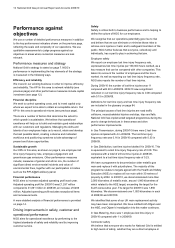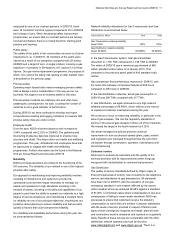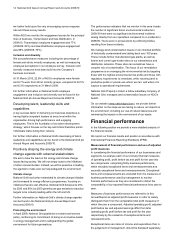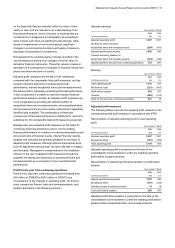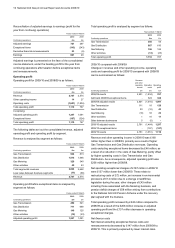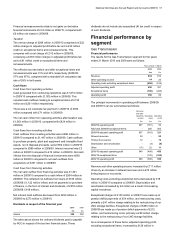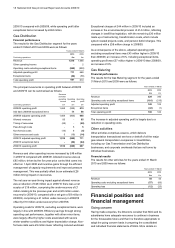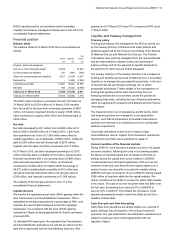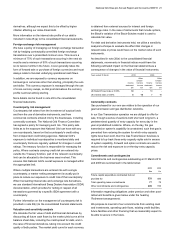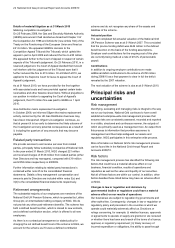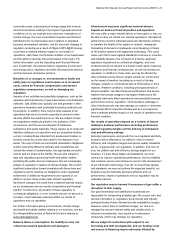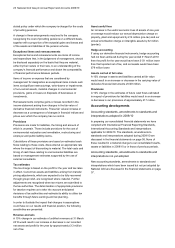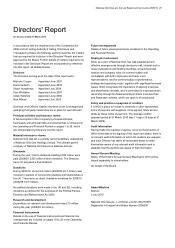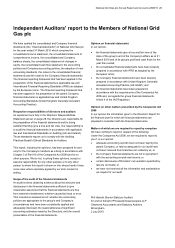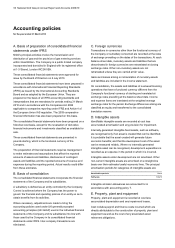National Grid 2010 Annual Report Download - page 22
Download and view the complete annual report
Please find page 22 of the 2010 National Grid annual report below. You can navigate through the pages in the report by either clicking on the pages listed below, or by using the keyword search tool below to find specific information within the annual report.
20 National Grid Gas plc Annual Report and Accounts 2009/10
Both short-term and long-term cash flow forecasts are produced
regularly to assist the treasury function in identifying short-term
liquidity and long-term funding requirements,and we seek to
enhance our cash flow forecasting processes on an ongoing
basis. Cash flow forecasts, supplemented by a financial
headroom analysis, are monitored regularly to assess funding
adequacy for at least a 12 month period.
As part of our regulatory arrangements, our operations are
subject to a number of restrictions on the way we can operate.
These include regulatory ‘ring fences’ that requires us to
maintain adequate financial resources and restricts our ability to
undertake transactions between certain National Grid
subsidiary companies including paying dividends, lending cash
or levy charges.
Funding and liquidity management
We maintain medium-term note and commercial paper
programmes to facilitate long and short-term debt issuance into
capital and money markets.
At 31 March 2010, NGG had a $2.5 billion US commercial
paper programme (unutilised), a $1.25 billion Euro commercial
paper programme (unutilised) and a €10.0 billion Euro medium-
term note programme (€5.7 billion issued).
In addition we have both committed and uncommitted bank
borrowing facilities that are available for general corporate
purposes to support our liquidity requirements. At 31 March
2010, the Company had £700 million of long-term committed
facilities (undrawn). Subsequent to year end these facilities
were renewed at a reduced level and now stand at £425 million,
expiring in April 2014.
We invest surplus funds on the money markets, usually in the
form of short-term fixed deposits and placements with money
market funds that are invested in highly liquid instruments of
high credit quality. Investment of surplus funds is subject to our
counterparty risk management policy, and we continue to
believe that our cash management and counterparty risk
management policies provide appropriate liquidity and credit
risk management. Details relating to cash, short-term
investments and other financial assets at 31 March 2010 are
shown in notes 15 and 16 to the consolidated financial
statements.
We believe that maturing amounts in respect of contractual
obligations as shown in commitments and contingencies in note
24 to the consolidated financial statements can be met from
existing cash and investments, operating cash flows and other
financings that we reasonably expect to be able to secure in the
future, together with the use of committed facilities if required.
Credit ratings
It is a condition of the regulatory ring-fence around the
Company that it uses reasonable endeavours to maintain an
investment grade credit rating. As of 31 March 2010, the long-
term senior unsecured debt and short-term debt credit ratings
respectively provided by Moody’s Investor Services, Standard &
Poor’s and Fitch were as follows (all with outlooks of stable):
Moody’s Investor Services A3/P2
Standard & Poor’s A-/A2
Fitch A/F2
Use of derivative financial instruments
As part of our business operations, including our treasury
activities, we are exposed to risks arising from fluctuations in
interest rates and exchange rates. We use financial
instruments, including financial derivatives, to manage
exposures of this type. Our policy is not to use financial
derivatives for trading purposes. More details on derivative
financial instruments are provided in note 12 to the consolidated
financial statements.
Refinancing risk management
Refinancing risk within National Grid is controlled mainly by
limiting the amount of debt maturities arising on borrowings in
any financial year.
Note 17 to the consolidated financial statements sets out the
contractual maturities of our borrowings over the next five
years, with total contracted borrowings maturing over 42 years.
We expect to be able to refinance this debt through the capital
and money markets as we have done during the year to 31
March 2010.
Interest rate risk management
Our interest rate exposure arising from borrowings and deposits
is managed by the use of fixed and floating rate debt and
derivative financial instruments, including interest rate swaps,
swaptions and forward rate agreements. The interest rate risk
management policy followed by National Grid is to seek to
minimise total financing costs (being interest costs and changes
in the market value of debt) subject to constraints so that, even
with an extreme movement in interest rates, neither the interest
cost nor the total financing cost is expected to exceed preset
limits with a high degree of certainty.
Some of NGG’s bonds in issue are inflation-linked, that is their
cost is linked to changes in the UK Retail Prices Index (RPI).
We believe that these bonds provide an appropriate hedge for
revenues and our regulatory asset values that are also RPI
linked under our price control formulas.
The performance of the treasury function in interest rate risk
management is measured by comparing the actual total
financing costs of the National Grid debt with those of a
passively managed benchmark portfolio with set ratios of fixed
rate to floating-rate debt, to identify the impact of actively
managing National Grid’s interest rate risk. This is monitored
regularly by the Finance Committee of National Grid.
Within the constraints of our interest rate risk management
policy, and as approved by the Finance Committee, we actively
manage our interest rate exposure and therefore the interest
rate profile shown at 31 March 2010 will change over time.
In 2010/11, we expect the financing costs of National Grid to
continue to benefit from low short-term interest rates, some of
which have already been locked in using short-term interest rate


